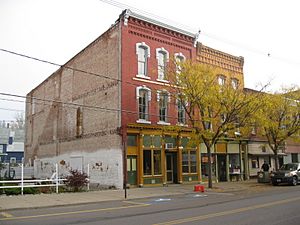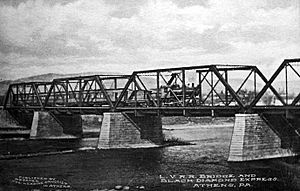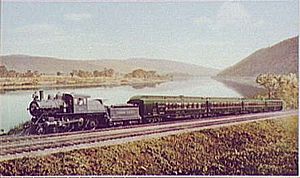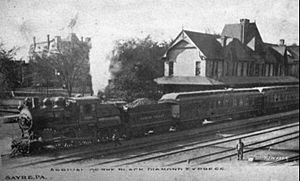Waverly, Tioga County, New York facts for kids
Quick facts for kids
Waverly, New York
|
|
|---|---|
|
Village
|
|

Downtown Waverly
|
|
| Country | United States |
| State | New York |
| County | Tioga |
| Incorporated | January 18, 1854 |
| Named for | Variant of Waverley |
| Government | |
| • Type | Mayor-Trusteeship |
| Area | |
| • Total | 2.31 sq mi (5.99 km2) |
| • Land | 2.28 sq mi (5.92 km2) |
| • Water | 0.03 sq mi (0.07 km2) |
| Elevation | 814 ft (248 m) |
| Population
(2020)
|
|
| • Total | 4,373 |
| • Density | 1,914.62/sq mi (739.14/km2) |
| Time zone | UTC-5 (Eastern (EST)) |
| • Summer (DST) | UTC-4 (EDT) |
| ZIP Code |
14892 14859 13734
|
| Area code(s) | 607 |
| FIPS code | 36-78806 |
| GNIS feature ID | 0968940 |
Waverly is the biggest village in Tioga County, New York, United States. In 2020, about 4,373 people lived there. It is located southeast of Elmira in a part of New York called the Southern Tier.
Waverly became an official village in 1854. It was named by Joseph "Uncle Joe" Hallett, who started the first Fire Department. He took the name from his favorite book, Waverley by Sir Walter Scott, but dropped one "e". The old village hall is a special building listed on the National Historic Places list.
Waverly is part of the larger Binghamton metropolitan area. It used to be a regular stop for the Black Diamond Express passenger train. The village is in the Penn-York Valley, a region that was once very busy with railroads. This valley includes Waverly in New York and nearby towns like South Waverly, Sayre, and Athens in Pennsylvania.
Contents
History of Waverly
Long ago, this area was a very important place for Native American tribes. They used it for travel, trading, and even battles. This was because of its special location where two rivers meet near the New York state border. The Chemung River flows into the Susquehanna River here, which then turns south into Pennsylvania. The Susquehannock people likely lived here for hundreds of years before Europeans arrived.
Early European Settlers
A French explorer named Étienne Brûlé was probably the first European to visit this area in 1615. He met with the Susquehannocks and traveled down the Susquehanna River. Later, after wars in the 1600s, the Iroquois tribe took control of the area. Their power was broken during the American Revolutionary War by the Sullivan Expedition. A major battle from that expedition, the Battle of Newtown, happened about 13 miles (21 km) west of Waverly in 1779.
John Shepard was an important early white settler. In 1796, he bought 1,000 acres (400 ha) of land, which included all of what would become Waverly. He built a mill on the Cayuta Creek. This settlement became known as Milltown, just across the border in Pennsylvania. Another mill site north of the border became known as Factoryville, which is now East Waverly. A smaller community called Villemont also grew nearby. When railroads started to become popular, the community began to grow quickly.
Railroads and Growth
Between 1849 and 1851, the New York & Erie Railroad reached the area. This connected Waverly to New York City to the east and Lake Erie to the west. In 1854, Waverly officially became a village.
Waverly became a very important railroad hub when the Lehigh Valley Railroad arrived in 1869. This railroad connected Waverly to Wilkes-Barre, Pennsylvania, linking the two major railway lines. This also helped the nearby town of Sayre, Pennsylvania grow, as it became home to the Lehigh Valley Railroad's train yards and shops. At the busiest time for railroads, about 41 trains came through Waverly every day! The village's population was almost three times larger than it is today.
Railroad History in the 19th Century

In 1870, a banker from Waverly named Howard Elmer, along with Charles Anthony and James Fritcher, bought land between Waverly and Athens. Elmer convinced Asa Packer to build a new railroad repair facility there for the growing Lehigh Valley Railroad. This helped the railroad connect to the Erie Railroad at Waverly. The town of Sayre was named after Robert Heysham Sayre, who helped make the deal happen. Sayre became famous for its large train yard and repair shops, which employed thousands of people.
20th Century Changes
In 1904, when the main locomotive shops were built in Sayre, the building was thought to be the largest in the world under one roof for a short time. The Lehigh Valley Railroad, which started in 1855 to transport coal, ran trains through Waverly until 1976. However, train maintenance moved away after World War II as trains switched from coal-powered steam engines to diesel engines. As the railroad industry changed, businesses and jobs in the valley decreased, and the population has gone down since 1940.
The biggest celebration in Waverly's history happened on August 26, 1910. It was called the Old Home Celebration, and it lasted four hours, filling the streets with people.
Many factories helped Waverly grow during this time. These included the Hall-Lyons furniture factory and the Manoil Manufacturing Co.. Manoil was famous for making hollow-cast toy soldiers, toy airplanes, and cars from 1937 to 1941. Other businesses in the 20th century included the Spencer Glove Company and the Waverly Sun newspaper. There was also Tioga Mills, Inc., which was a feed mill, and Agway (Country Foods Division), which made pet food. Other businesses were Food and Drug Research Laboratories, the State Line Auto Auction, and O’Brien's Inn, known for its great views. The J. E. Rodeo Ranch also operated nearby in Barton during the 1940s and 1950s.
Several historic buildings in Waverly are listed on the National Register of Historic Places. These include Grace Episcopal Church, the United States Post Office, Waverly Village Hall, and the former Mary W. Muldoon High School.
Waverly is located in a river valley in the Allegheny Plateau. It's just north of where the Susquehanna and Chemung rivers meet. Waverly, along with Athens, Pennsylvania, and South Waverly, Pennsylvania, make up a larger area called the Penn-York Valley. This area crosses the border between New York and Pennsylvania. There isn't a clear physical border between these towns; their streets and avenues connect smoothly.
Waverly's Geography
Waverly is located at coordinates 42°0′19″N 76°32′16″W.
The village covers about 2.3 square miles (6.1 km2) in total. Most of this area, 2.3 square miles (5.9 km2), is land, and a small part, 0.1 square miles (0.1 km2), is water.
The Chemung River flows along the western edge of the village. It joins the Susquehanna River about 6 miles (10 km) south of Waverly in Athens Township, Pennsylvania. Another river that flows into the Susquehanna, Cayuta Creek (also called Shepard's Creek), goes through the eastern part of the village before joining the Susquehanna in Sayre, Pennsylvania.
Waverly is very close to New York state's southern border. Because of this, it's part of a bigger community that includes towns in Bradford County, Pennsylvania. Waverly, South Waverly, Sayre, and Athens, Pennsylvania together form the "Penn-York Valley" or simply "The Valley." This area has the state border running right through it. Waverly is also a short distance from the border of Chemung County to the west.
Waverly's Climate
| Climate data for Waverly, New York (1991–2020 normals, extremes 1893–1915 and 1988–present) | |||||||||||||
|---|---|---|---|---|---|---|---|---|---|---|---|---|---|
| Month | Jan | Feb | Mar | Apr | May | Jun | Jul | Aug | Sep | Oct | Nov | Dec | Year |
| Record high °F (°C) | 71 (22) |
74 (23) |
86 (30) |
93 (34) |
97 (36) |
101 (38) |
103 (39) |
101 (38) |
97 (36) |
91 (33) |
78 (26) |
69 (21) |
103 (39) |
| Mean maximum °F (°C) | 57.4 (14.1) |
58.1 (14.5) |
67.9 (19.9) |
80.8 (27.1) |
87.9 (31.1) |
91.9 (33.3) |
93.7 (34.3) |
92.0 (33.3) |
89.3 (31.8) |
79.5 (26.4) |
69.5 (20.8) |
57.8 (14.3) |
95.8 (35.4) |
| Mean daily maximum °F (°C) | 34.4 (1.3) |
37.0 (2.8) |
45.3 (7.4) |
58.7 (14.8) |
71.0 (21.7) |
79.3 (26.3) |
83.4 (28.6) |
81.7 (27.6) |
74.7 (23.7) |
62.1 (16.7) |
49.8 (9.9) |
39.1 (3.9) |
59.7 (15.4) |
| Daily mean °F (°C) | 25.3 (−3.7) |
26.9 (−2.8) |
34.5 (1.4) |
46.3 (7.9) |
57.8 (14.3) |
66.8 (19.3) |
70.9 (21.6) |
69.5 (20.8) |
62.3 (16.8) |
50.6 (10.3) |
40.0 (4.4) |
31.0 (−0.6) |
48.5 (9.2) |
| Mean daily minimum °F (°C) | 16.1 (−8.8) |
16.8 (−8.4) |
23.7 (−4.6) |
34.0 (1.1) |
44.7 (7.1) |
54.4 (12.4) |
58.4 (14.7) |
57.3 (14.1) |
49.9 (9.9) |
39.0 (3.9) |
30.1 (−1.1) |
22.9 (−5.1) |
37.3 (2.9) |
| Mean minimum °F (°C) | −3.5 (−19.7) |
−0.1 (−17.8) |
6.7 (−14.1) |
21.8 (−5.7) |
31.4 (−0.3) |
40.5 (4.7) |
47.9 (8.8) |
47.1 (8.4) |
37.0 (2.8) |
26.9 (−2.8) |
15.8 (−9.0) |
7.1 (−13.8) |
−5.4 (−20.8) |
| Record low °F (°C) | −31 (−35) |
−25 (−32) |
−17 (−27) |
10 (−12) |
20 (−7) |
28 (−2) |
35 (2) |
33 (1) |
23 (−5) |
15 (−9) |
4 (−16) |
−25 (−32) |
−31 (−35) |
| Average precipitation inches (mm) | 2.17 (55) |
1.84 (47) |
2.61 (66) |
3.40 (86) |
3.05 (77) |
4.34 (110) |
3.64 (92) |
3.33 (85) |
4.02 (102) |
3.55 (90) |
2.43 (62) |
2.43 (62) |
36.81 (935) |
| Average precipitation days (≥ 0.01 in) | 11.3 | 9.5 | 10.4 | 12.3 | 11.9 | 12.0 | 11.4 | 10.5 | 10.3 | 11.6 | 9.8 | 11.4 | 132.4 |
| Source: NOAA | |||||||||||||
Waverly's Population
| Historical population | |||
|---|---|---|---|
| Census | Pop. | %± | |
| 1870 | 2,239 | — | |
| 1880 | 2,767 | 23.6% | |
| 1890 | 4,123 | 49.0% | |
| 1900 | 4,465 | 8.3% | |
| 1910 | 4,855 | 8.7% | |
| 1920 | 5,270 | 8.5% | |
| 1930 | 5,662 | 7.4% | |
| 1940 | 5,450 | −3.7% | |
| 1950 | 6,037 | 10.8% | |
| 1960 | 5,950 | −1.4% | |
| 1970 | 5,261 | −11.6% | |
| 1980 | 4,738 | −9.9% | |
| 1990 | 4,787 | 1.0% | |
| 2000 | 4,607 | −3.8% | |
| 2010 | 4,444 | −3.5% | |
| 2020 | 4,373 | −1.6% | |
| U.S. Decennial Census | |||
In 2000, there were 4,607 people living in Waverly. About 30.4% of homes had children under 18. The average household had 2.32 people, and the average family had 2.98 people.
The population was spread out by age:
- 24.0% were under 18
- 8.1% were 18 to 24
- 27.2% were 25 to 44
- 20.3% were 45 to 64
- 20.4% were 65 or older
The average age was 39 years old. For every 100 females, there were about 84.1 males.
Education in Waverly
Waverly is part of the Waverly Central School District.
Here are the schools in the district:
- Elementary Schools
- Elm Street Elementary School
- Lincoln Street Elementary School
- Chemung Elementary School
- Middle and High Schools
- Waverly High School
- Waverly Middle School
- Religious Schools
- Zion Ministerial Institute
- Colleges
- Broome Community College (Ithaca Street campus)
Local Museums
- SRAC (Susquehanna River Archeological Center)
This center opened in 2008. It helps people learn about and protect Native American history and culture in the region. The center has a gift shop, a lecture hall, and an exhibit hall. It is located on Broad Street in downtown Waverly.
Transportation Around Waverly
Downtown Waverly is right next to the Southern Tier Expressway, which is New York State Route 17. This road will soon be called Interstate 86. You can get onto NY 17 from both the east and west sides of the village. New York State Route 17C and New York State Route 34 also meet on the eastern side of Waverly. Also, U.S. Route 220 ends at NY 17C (Chemung Street) on the west side of the village, near the state border.
Waverly has two local bus services: Ride Tioga and BeST Transit. Ride Tioga is a county bus service that stops in Waverly and Barton. BeST Transit travels through the Penn-York Valley and Bradford County, Pennsylvania. You can also find regional bus services like Shortline Coach USA and Greyhound in Waverly. Valley Taxi Service offers taxi rides around the Penn-York Valley, Elmira, Towanda, and Binghamton.
Waverly is also conveniently located between two medium-sized regional airports: the Elmira-Corning Regional Airport and the Greater Binghamton Airport. These airports serve the Southern Tier of New York.
Media in Waverly
Newspapers
- Morning Times (based in Sayre; covers Waverly, Sayre, Athens, and nearby areas)
- The Daily Review (based in Towanda; covers the Penn-York Valley and Bradford County)
- Star Gazette (based in Elmira; covers Tioga, Chemung, and Steuben Counties in NY and Bradford County in PA)
Radio Stations
- WAVR - 102.1 FM (based in Sayre; licensed in Waverly)
- WATS - 960 AM (based in Sayre; licensed in Sayre)
- WCIH - 94.3 FM (based in Elmira; licensed in Elmira)
- WEBO - 1330 AM (based in Owego; branded for Waverly)
- WENI-FM - 92.7 FM (based in Elmira; licensed in S. Waverly)
- W297BG - 107.3 FM (licensed in Ulster, Pennsylvania)
Television Channels
Waverly gets TV channels from two different areas, plus Time Warner Cable News.
- Binghamton: WBNG (CBS), WIVT (ABC), WBGH (NBC), WICZ (Fox), and WSKG (Public Television)
- Elmira: WETM (NBC), WENY (ABC & CBS), and WYDC (Fox)
Sports in Waverly
Waverly once had a professional baseball team in 1901 called the Waverly Wagonmakers. The team stopped playing when the New York State League ended in 1917.
Waverly is also home to the Waverly Little League, which started in 1949. The Waverly School District has many sports teams, including:
- Football
- Baseball
- Basketball
- Bowling
- Golf
- Tennis
- Soccer
- Wrestling
- Track
- Cross country
Waverly's wrestling and track teams are often ranked highly in the state and even nationally. Many smaller bowling leagues also play at the Valley Bowling Center in Waverly. Waverly Memorial Stadium is where soccer and football games are played.
Notable People from Waverly
Many interesting people have connections to Waverly:
- J. Weston Allen - a politician
- Linda Bangs - a saxophonist
- Jeffrey L. Barnhart - a member of the North Carolina General Assembly
- Geoff Bodine - a professional NASCAR race car driver and inventor of the Bo-Dyn Bobsled. He graduated from Waverly High School.
- Brett Bodine - a professional NASCAR race car driver, also a Waverly High School graduate.
- Todd Bodine - another professional NASCAR race car driver who graduated from Waverly High School.
- Lauren Cohen - an economist
- Charles Martin Crandall - an inventor and toy-maker
- Christopher Erb - a marketing executive
- Jim Farr - a professional baseball player
- Jeff Foote - an NBA player
- Les Goble - an American football player
- William Elting Johnson - a doctor and politician
- Cabot Lyford – a sculptor who grew up in Waverly
- Harriet Newell Ralston (1828-1920) - an American poet
- Miriam Shearing - a lawyer and retired judge
- Heinie Wagner - a baseball player who started his career with the Waverly Wagonmakers.
Recent Events and Developments
Two Rivers State Park
In 2005, a large area of 600 acres (2.4 km2) of woodlands was named Two Rivers State Park. This park includes the Waverly Reservoir property and Waverly Glen park. It's called "Two Rivers" because it's just north of where the Chemung River meets the Susquehanna River. The park has hiking and biking trails, a large pond, picnic tables, a basketball court, tennis courts, children's play equipment, and barbecue areas.
Tioga Downs Horse Racing
In 2006, the horse racing track at Tioga Downs in nearby Nichols, NY, was expanded. It now includes a Racino, which means it has casino facilities.
Downtown Preservation Efforts
In 2007, part of the old Snyder Hotel building in downtown Waverly collapsed during a bad storm. This caused concerns about the safety of other historic buildings on Broad Street. The village tried to get state funding to help fix or tear down these buildings but was not successful. In 2008, voters approved a tax increase to buy and move all village services to the former Ithaca Street School. This was because the old Waverly Village Hall was too small. In 2012, the village sold the old Village Hall building to someone who agreed to protect its historical importance.
Manufacturers in Waverly
Waverly is home to several manufacturing companies:
- Advanced Drainage Systems, Inc. (formerly Hancor, Inc.) - This company makes corrugated plastic drainage pipes from HDPE.
- Granite Works, LLC - This company makes countertops from granite, quartz, and other materials. They get their supplies from places like Brazil, Italy, and China.
- Hagen Pet Foods, Inc - Hagen makes and sells pet foods like milk, dry food, moist food, and treats for dogs and cats. They also make animal feed.
- Leprino Foods Company - This factory makes mozzarella cheese from milk provided by local dairy farms. It is the biggest employer in Waverly and the largest supplier of cheese for pizza chains in the eastern United States. The New York/Pennsylvania state line actually runs through the middle of this factory! Their main company is also a big producer of sweet whey, whey protein, and lactose products.
- Rynone Manufacturing Corp. - Rynone makes cultured marble vanity tops, natural granite and marble vanity tops, laminate countertops, and other custom furniture parts.
See also
 In Spanish: Waverly (condado de Tioga, Nueva York) para niños
In Spanish: Waverly (condado de Tioga, Nueva York) para niños





